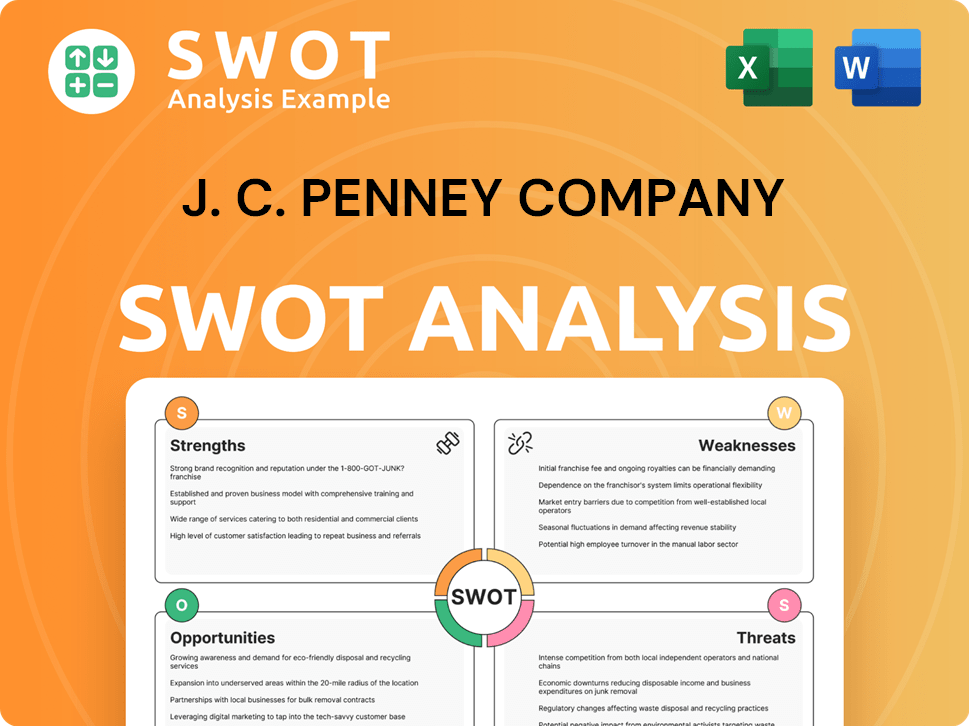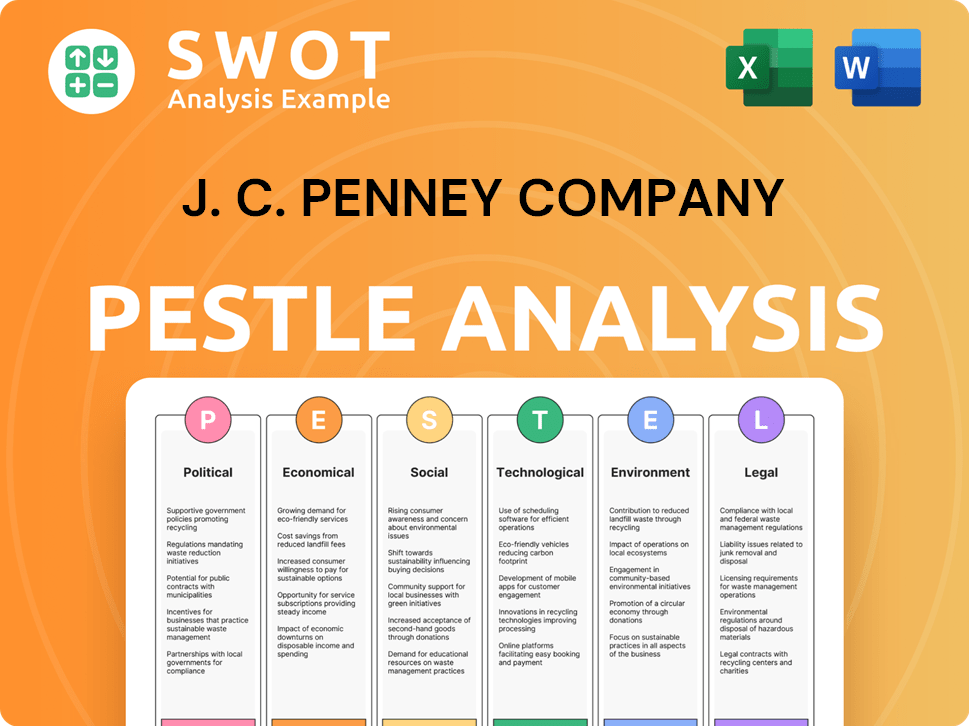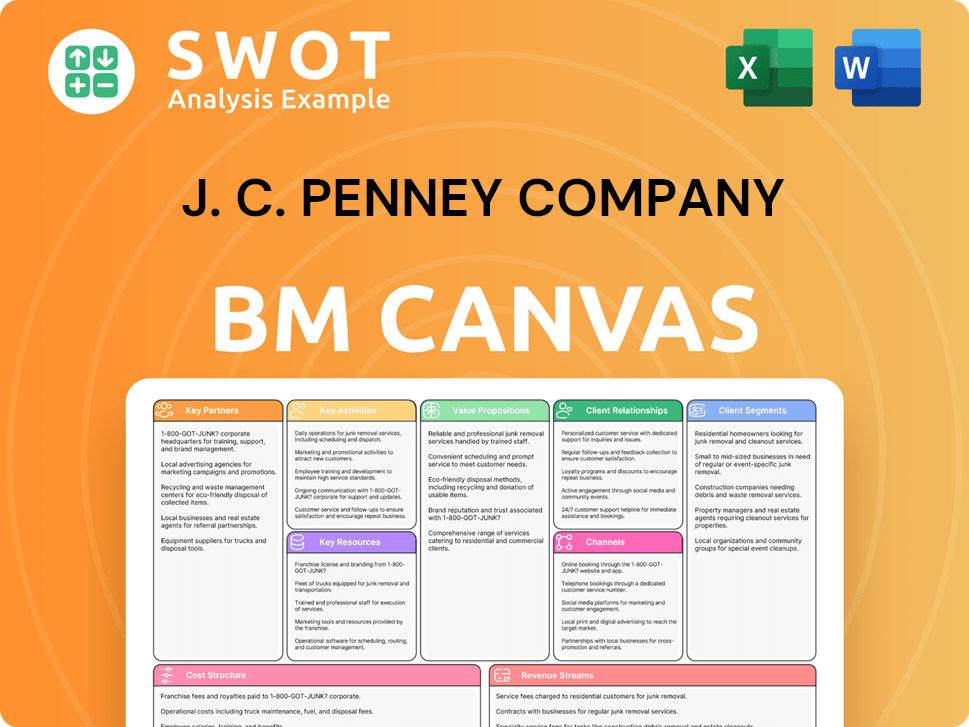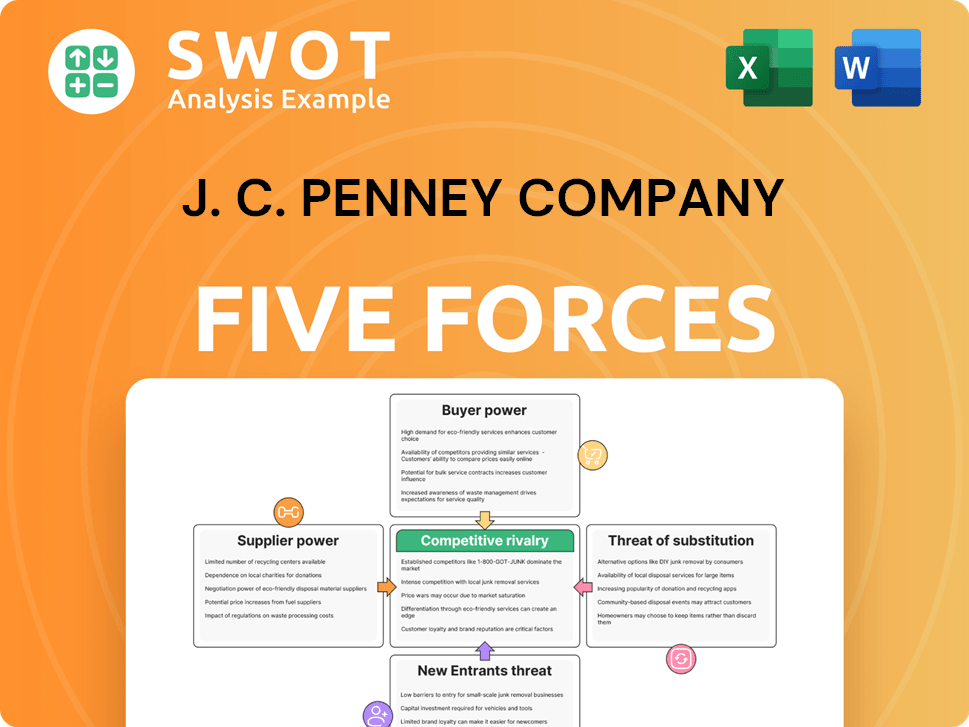J. C. Penney Company Bundle
Who Really Owns J. C. Penney Now?
Navigating the ever-changing retail landscape demands a deep understanding of corporate ownership, and few stories are as compelling as that of J. C. Penney. From its humble beginnings as the Golden Rule store to its recent transformation, the J. C. Penney Company SWOT Analysis reveals the critical role ownership plays in a company's survival and strategic direction. Understanding the current owner of J. C. Penney is key to grasping its future.

The evolution of JCPenney's ownership, from its founding in 1902 to its present form as part of Catalyst Brands, offers valuable insights into the dynamics of the retail industry. The Chapter 11 bankruptcy filing significantly reshaped the JCPenney owner structure, highlighting the impact of financial events on corporate control. This analysis will explore who owns J. C. Penney, examining the key stakeholders and how their influence shapes the company's strategy and governance, including the J. C. Penney shareholders.
Who Founded J. C. Penney Company?
The story of J. C. Penney, a retail giant, begins with James Cash Penney, who established 'The Golden Rule' on April 14, 1902, in Kemmerer, Wyoming. This marked the start of what would become a significant player in the retail industry. The early days of J. C. Penney's ownership were defined by James Cash Penney's vision and the company's commitment to fair practices.
James Cash Penney's journey in retail started with his experience working for Thomas Callahan and Guy Johnson's Golden Rule stores. They recognized his dedication and offered him a partnership. Penney invested $2,000 to become a one-third partner in a new store, setting the foundation for his future endeavors. This initial partnership was crucial in shaping the company's early ownership structure.
By 1907, James Cash Penney had bought out his original partners, gaining sole control of the existing stores. This move demonstrated his ambition to expand the 'Golden Rule' concept. The company was formally incorporated as J. C. Penney Company in 1913, with William Henry McManus listed as a co-founder.
James Cash Penney, Guy Johnson, and Thomas Callahan were the initial partners in the Golden Rule stores.
By 1912, Penney had expanded to 34 stores in the Rocky Mountain States.
The company was incorporated as J. C. Penney Company in 1913.
By 1917, the company operated 175 stores across 22 states.
Initially, the company operated on a cash-only policy.
Credit operations were introduced in 1962.
The early ownership of J. C. Penney, or JCPenney, was centered around James Cash Penney's vision and his commitment to fair business practices. The company's growth was rapid, expanding from a few stores to a nationwide presence within a few decades. Understanding the Competitors Landscape of J. C. Penney Company provides further insights into the company's position in the market.
- James Cash Penney opened his first store in 1902.
- Penney bought out his partners by 1907.
- The company incorporated in 1913.
- By 1917, JCPenney had expanded to 175 stores.
J. C. Penney Company SWOT Analysis
- Complete SWOT Breakdown
- Fully Customizable
- Editable in Excel & Word
- Professional Formatting
- Investor-Ready Format

How Has J. C. Penney Company’s Ownership Changed Over Time?
The ownership of the J. C. Penney Company, often referred to as Penney's or JCP, has seen significant changes over time. Initially a publicly traded company since 1927, with shares traded on the New York Stock Exchange, it transitioned to a privately held entity. This transformation was largely due to the Chapter 11 bankruptcy filing in May 2020, triggered by declining sales and the economic impact of the COVID-19 pandemic. This pivotal event reshaped the company's ownership structure.
The bankruptcy led to an acquisition in late 2020 by Simon Property Group (SPG) and Brookfield Asset Management (BAM) for approximately $1.75 billion. This deal involved both cash and assumed debt. As a result, Simon and Brookfield took ownership of the retail and operational assets. The distribution centers and other real estate holdings were controlled by the Ad Hoc Group of First Lien Lenders through a separate real estate investment trust (REIT) and property holding company (PropCos). The Growth Strategy of J. C. Penney Company has been impacted greatly by these ownership changes.
| Event | Date | Impact on Ownership |
|---|---|---|
| Initial Public Offering | 1927 | Became a publicly traded company. |
| Chapter 11 Bankruptcy Filing | May 2020 | Led to potential acquisition and restructuring. |
| Acquisition by SPG and BAM | Late 2020 | Transitioned to private ownership. |
| Merger with SPARC Group | January 2025 | Formation of Catalyst Brands, changing ownership structure. |
In January 2025, JCPenney merged with SPARC Group, resulting in Catalyst Brands. The major stakeholders of Catalyst Brands, and by extension the current owner of J. C. Penney, include Simon Property Group, Brookfield Corporation, Authentic Brands Group, and Chinese e-tailer Shein. This strategic alliance aims to streamline operations, with Catalyst Brands reporting over $9 billion in revenue, operating over 1,800 stores, and employing around 60,000 people. This consolidation reflects a strategic shift in ownership, aiming to leverage synergies and adapt to evolving market dynamics.
The ownership of J. C. Penney has evolved significantly, from public to private control, and now includes major stakeholders like Simon Property Group and Brookfield Corporation.
- The bankruptcy filing in 2020 was a turning point, leading to new ownership.
- The merger with SPARC Group created Catalyst Brands, changing the ownership landscape.
- Current major stakeholders include Simon Property Group, Brookfield Corporation, Authentic Brands Group, and Shein.
- The company operates over 1,800 stores and has around 60,000 employees.
J. C. Penney Company PESTLE Analysis
- Covers All 6 PESTLE Categories
- No Research Needed – Save Hours of Work
- Built by Experts, Trusted by Consultants
- Instant Download, Ready to Use
- 100% Editable, Fully Customizable

Who Sits on J. C. Penney Company’s Board?
Following its restructuring after bankruptcy, the current ownership of J. C. Penney Company, often referred to as Penney's or JCP, is primarily held by Simon Property Group and Brookfield Asset Management. These entities acquired the department store chain in 2020. The board of directors now includes representatives from these major stakeholders, reflecting the shift in J. C. Penney ownership. The specific details of the equity split and voting power of individual board members are not fully public due to its private ownership status.
The board of directors includes key figures such as Stanley Shashoua, Senior Vice President - International at Simon Property Group, who serves as the Executive Chairman. Michelle Wlazlo is the current CEO of the department store. Alan Carr and Steve Panagos also hold positions on the board. The influence of Simon Property Group and Brookfield Corporation is significant in strategic decision-making, given their controlling stakes. For more context on the company's past, you can explore the Brief History of J. C. Penney Company.
| Board Member | Title | Affiliation |
|---|---|---|
| Stanley Shashoua | Executive Chairman | Simon Property Group |
| Michelle Wlazlo | CEO | JCPenney |
| Alan Carr | VP/Chief Restructuring Officer | JCPenney |
| Steve Panagos | Secretary | JCPenney |
Prior to the acquisition, J. C. Penney Company, Inc. operated with a standard one-share-one-vote structure. This meant that each share of common stock entitled its holder to one vote on all matters submitted to a stockholder vote, including director elections. There was no cumulative voting, and holders of common stock were not entitled to preemptive rights. The current ownership structure, however, has shifted with the involvement of Simon Property Group and Brookfield Asset Management.
J. C. Penney's ownership is now primarily held by Simon Property Group and Brookfield Asset Management.
- The board of directors includes representatives from these major stakeholders.
- Stanley Shashoua of Simon Property Group serves as Executive Chairman.
- Michelle Wlazlo is the current CEO.
- The company emerged from bankruptcy with a new ownership structure.
J. C. Penney Company Business Model Canvas
- Complete 9-Block Business Model Canvas
- Effortlessly Communicate Your Business Strategy
- Investor-Ready BMC Format
- 100% Editable and Customizable
- Clear and Structured Layout

What Recent Changes Have Shaped J. C. Penney Company’s Ownership Landscape?
The recent ownership landscape of JCPenney, often referred to as JCP, has been significantly reshaped over the past few years. Following its bankruptcy in 2020, the company transitioned from a publicly traded entity to private ownership. This shift culminated in the formation of Catalyst Brands in January 2025. This acquisition by Simon Property Group and Brookfield Asset Management for $1.75 billion marked a significant change, driven by the strategic interest of these mall operators in maintaining JCPenney as a key anchor tenant within their properties.
A key development in the J. C. Penney company's recent history is the consolidation with SPARC Group to create Catalyst Brands. This move brought together JCPenney with other retail brands under a single operational umbrella. The shareholders of Catalyst Brands now include Simon Property Group, Brookfield Corporation, Authentic Brands Group, and Shein. This new entity launched with over $9 billion in revenue, 1,800 stores, and 60,000 employees, reflecting a wider trend of consolidation in the retail sector. Understanding the JCPenney owner and the company's current structure is crucial for anyone interested in the retail industry.
| Key Players | Ownership Stake | Role |
|---|---|---|
| Simon Property Group | Significant | Co-owner, strategic partner |
| Brookfield Corporation | Significant | Co-owner, strategic partner |
| Authentic Brands Group | Minority | Partner |
| Shein | Minority | Partner |
JCPenney, under its new ownership, is undergoing a $1 billion reinvestment plan, announced in September 2023, with the aim of upgrading its stores by 2025. This includes investments in new technology and enhancements to distribution centers. While the company is privately held, some financial data is available through SEC filings related to property trusts. For those keen on understanding the consumer base, exploring the Target Market of J. C. Penney Company can provide valuable insights.
The primary owners of JCPenney are Simon Property Group and Brookfield Corporation, following the company's acquisition out of bankruptcy.
Catalyst Brands is a new entity formed through the consolidation of JCPenney with SPARC Group, bringing together multiple retail brands under one umbrella.
While privately held, JCPenney is undergoing a $1 billion reinvestment plan. Financial data is available through SEC filings related to property trusts.
Information on the current management team can be found through Catalyst Brands and related corporate filings.
J. C. Penney Company Porter's Five Forces Analysis
- Covers All 5 Competitive Forces in Detail
- Structured for Consultants, Students, and Founders
- 100% Editable in Microsoft Word & Excel
- Instant Digital Download – Use Immediately
- Compatible with Mac & PC – Fully Unlocked

Related Blogs
- What are Mission Vision & Core Values of J. C. Penney Company Company?
- What is Competitive Landscape of J. C. Penney Company Company?
- What is Growth Strategy and Future Prospects of J. C. Penney Company Company?
- How Does J. C. Penney Company Company Work?
- What is Sales and Marketing Strategy of J. C. Penney Company Company?
- What is Brief History of J. C. Penney Company Company?
- What is Customer Demographics and Target Market of J. C. Penney Company Company?
Disclaimer
All information, articles, and product details provided on this website are for general informational and educational purposes only. We do not claim any ownership over, nor do we intend to infringe upon, any trademarks, copyrights, logos, brand names, or other intellectual property mentioned or depicted on this site. Such intellectual property remains the property of its respective owners, and any references here are made solely for identification or informational purposes, without implying any affiliation, endorsement, or partnership.
We make no representations or warranties, express or implied, regarding the accuracy, completeness, or suitability of any content or products presented. Nothing on this website should be construed as legal, tax, investment, financial, medical, or other professional advice. In addition, no part of this site—including articles or product references—constitutes a solicitation, recommendation, endorsement, advertisement, or offer to buy or sell any securities, franchises, or other financial instruments, particularly in jurisdictions where such activity would be unlawful.
All content is of a general nature and may not address the specific circumstances of any individual or entity. It is not a substitute for professional advice or services. Any actions you take based on the information provided here are strictly at your own risk. You accept full responsibility for any decisions or outcomes arising from your use of this website and agree to release us from any liability in connection with your use of, or reliance upon, the content or products found herein.